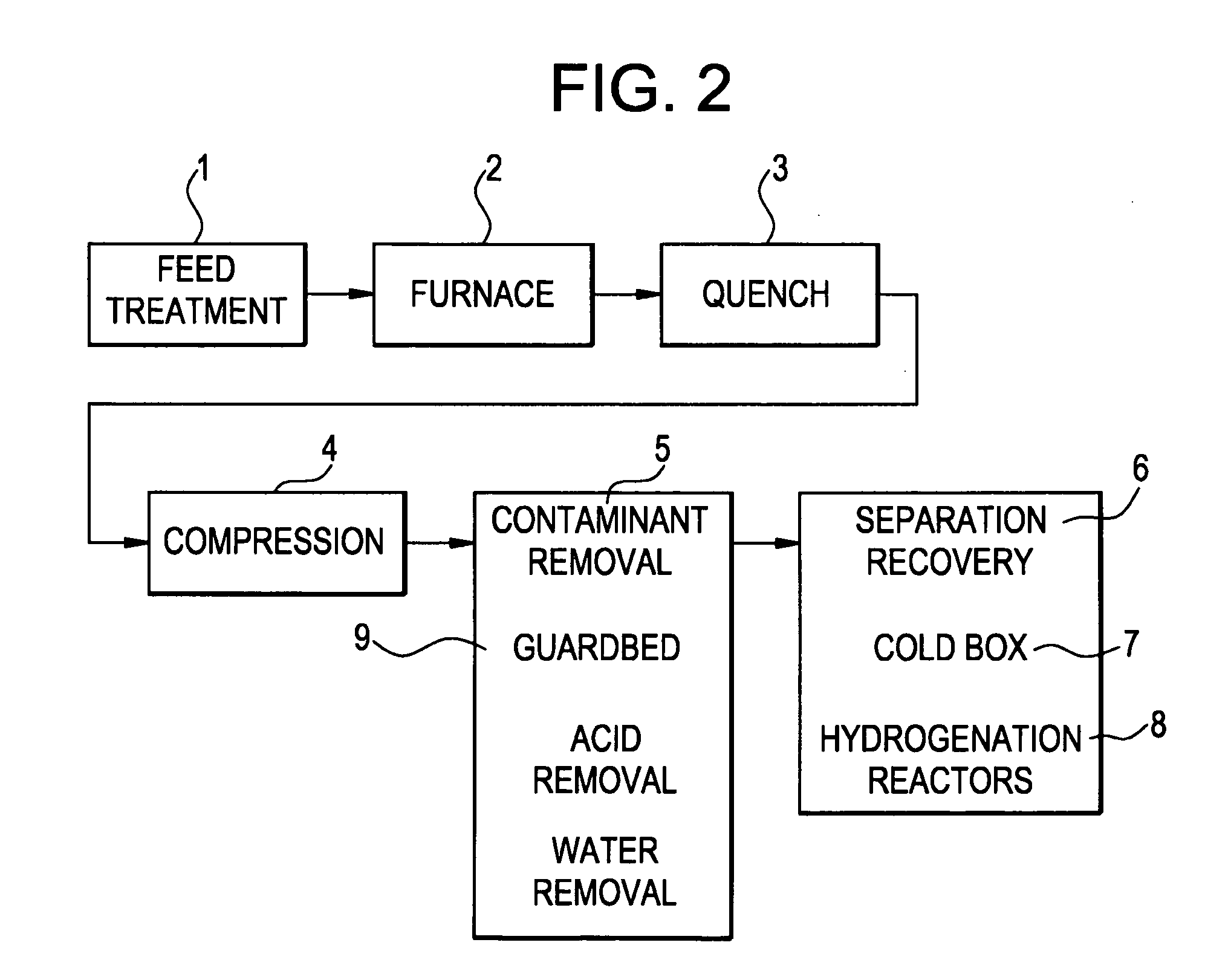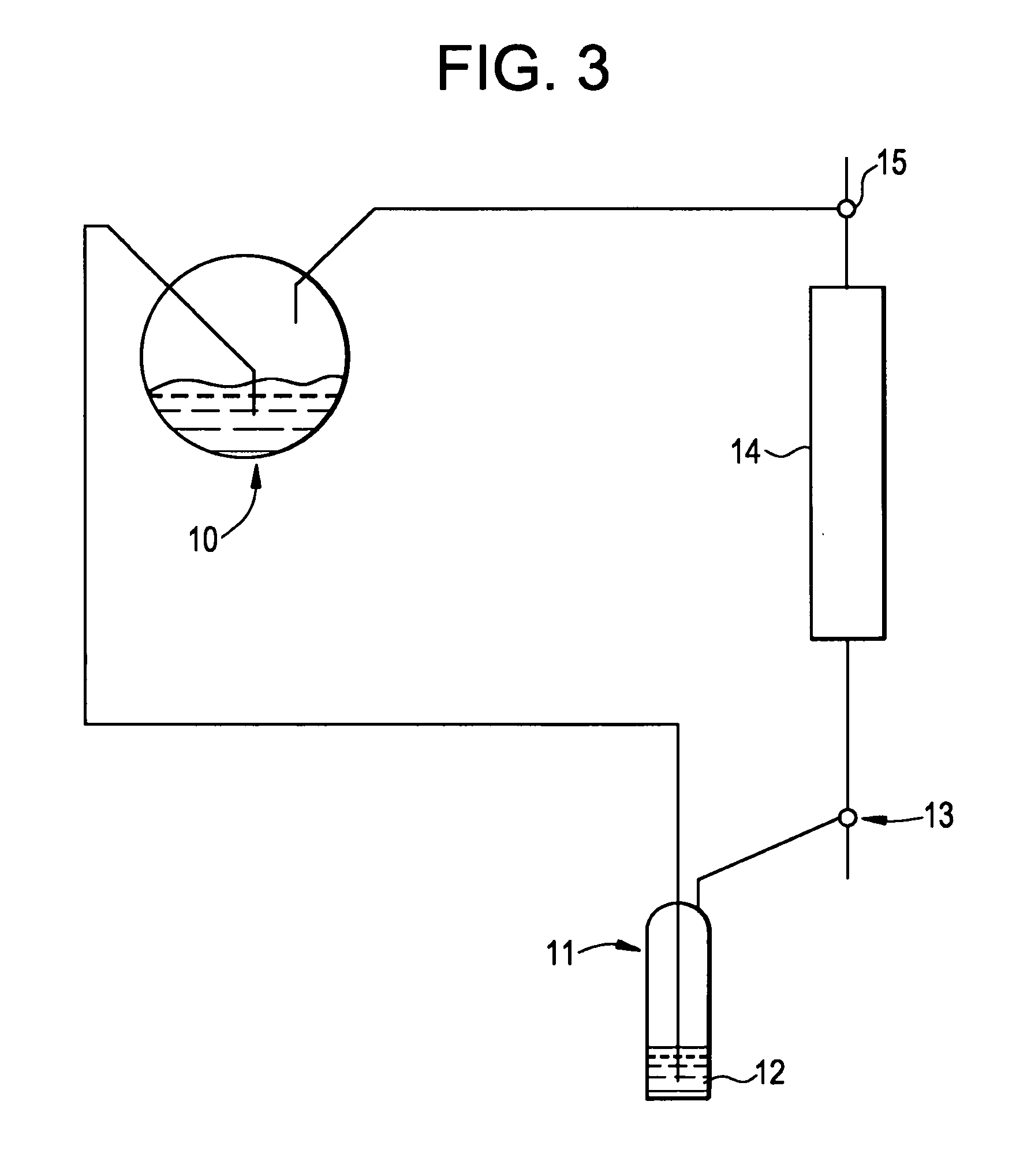Method for removal of mercury from hydrocarbon feedstocks
a hydrocarbon feedstock and mercury technology, applied in the field of mercury removal, can solve the problems of industrial hygiene and environmental risks, mechanical strength,
- Summary
- Abstract
- Description
- Claims
- Application Information
AI Technical Summary
Benefits of technology
Problems solved by technology
Method used
Image
Examples
example 1
Comparative Example, not According to the Present Invention
[0061]A composition with six weight percent silver (as reported by the vendor) on gamma-alumina in the shape of spheres between 2 and 4 mm in diameter (T-2552A, Sud Chemie, Munich, Germany) is installed in a vessel and reduced at 200° C. and 4 bar pressure with a mixture of 8 vol percent hydrogen in methane. The is cooled down under the same gas flow, and at ambient temperature, using the same gas mixture of 8 vol percent hydrogen in methane, the pressure is increased to 6 bar and the supply of reducing gas is stopped. The bed is then pressurized and brought on stream using cracked gas. The average composition of this cracked gas includes carbon monoxide (0.07 vol %), hydrogen (13 vol %), methane (27 vol %), acetylene (0.5 vol %), ethylene (33 vol %), ethane (4 vol %), methylacetylene (0.35 vol %), 1,3 propadiene (0.25 vol %), propylene (13 vol %), propane (0.4 vol %), 1,3-butadiene (3 vol %), butene (3 vol %), n-butane (0.5...
example 2
Comparative Example, not According to the Present Invention
[0062]A second run of the same used in Example 1, using the same vessel, but using half the amount of the and adding a zeolite molecular sieve in a 3:1 ratio to the, is done using the same pretreatment and running at the same operating conditions, with the same cracked gas composition, except that residence time in the guard bed is about 5 seconds and the residence time in the molecular sieve is about 15 seconds. The inlet and outlet water concentration of the guard bed is measured and both found to be less than 0.10 wt ppm. This time the bed outlet is additionally monitored for components with a high boiling temperature. In the outlet dimethylfulvene and the oligomers of dimethylfulvene with cyclopentadiene are found. So much heavy components are formed that a separate liquid phase is created in the guard bed. The liquid is in equilibrium with the gas phase and therefore consists of ±40% of C4 components like butadiene and ...
example 3
Comparative Example, not According to the Present Invention
[0063]Before the run is started, the amount of mercury in the feed is about 34 ug / m3. During 3 weeks of operation, the mercury concentration rises to 45 ug / m3. A sulfur on activated carbon adsorbent in the shape of pellets having 4.5 mm diameter (HGR-P® impregnated granular activated carbon for mercury removal, Calgon Carbon Corporation, Pittsburgh Pa. USA) is loaded in the vessel described in Example 1 and dried through vacuum drying. A methane flow is started through the bed and to this gas the cracked gas described in Example 1 is added in increasing amount to condition the activated carbon to the hydrocarbons in the process stream. The conditioning acclimates the activated carbon to the hydrocarbon species, thus minimizing the heat generation and potential damage to the composition due to adsorption of contaminant on the carbon surface. Once the bed is fully conditioned the bed is pressurized and placed on stream at 15° ...
PUM
| Property | Measurement | Unit |
|---|---|---|
| diameter | aaaaa | aaaaa |
| diameter | aaaaa | aaaaa |
| temperatures | aaaaa | aaaaa |
Abstract
Description
Claims
Application Information
 Login to View More
Login to View More - R&D
- Intellectual Property
- Life Sciences
- Materials
- Tech Scout
- Unparalleled Data Quality
- Higher Quality Content
- 60% Fewer Hallucinations
Browse by: Latest US Patents, China's latest patents, Technical Efficacy Thesaurus, Application Domain, Technology Topic, Popular Technical Reports.
© 2025 PatSnap. All rights reserved.Legal|Privacy policy|Modern Slavery Act Transparency Statement|Sitemap|About US| Contact US: help@patsnap.com



